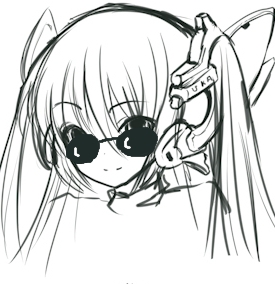
Written by A. H. on 02 Jun 2016
Over the years here at UK Anime we've spoken to numerous unique and engaging figures from across the anime business, but we suspect none of them can match the sheer breadth of experience paraded by Michael Arias.
Arias' story has taken him from childhood memories of extracting explosives from fireworks, stuffing them into various models and then filming them as they blow up through to working with the Wachowski's on the ground-breaking Animatrix anthology, then onto directing the award-winning Tekkonkinkreet and - more recently - his anime adaptation of Project Itoh novel Harmony. Oh, and he also happened to be a key member of staff that developed Toon Shaders, a software application for digital animation that came to be used by Studio Ghibli as they entered the digital realm with Princess Mononoke and, later, the Oscar-winning Spirited Away. These substantial achievements are made all the more impressive by the fact that Arias isn't a Japanese native, making him something of a rarity as a western talent in an industry that rarely sees outsiders exert such influence over its productions.
Sitting down to talk to the man himself turned out to also be a suitably unique experience. Softly spoken, self-effacing and honest to a fault, Michael Arias isn't one to take any question lightly, nor is he one for placatory answers. Thus, every question we fielded was carefully picked up by the director, mentally turned over and over as he analysed and built his thoughts on the topic at hand before providing and reinforcing his answer. It made for an engaging conversation that one suspects could have gone on for hours more as he deconstructed and analysed his career before us, while also providing plenty of insight into both the anime industry and the production processes within it.
Of course, it was with digital animation software and Toon Shaders that Arias really made his break into the industry in a distinctly unique manner, and given the success of that software he's clearly better qualified than most to comment on the current state of CG technology in the anime industry - something he wasn't shy about professing disappointment in.
"It sounds self-important, but I think Tekkonkinkreet is the last really big paradigm shift in the use of 3D in traditional animation - I think Tekkonkinkreet really put 3D and hand-drawn artwork together in a more or less seamless way; it was the last watershed and I haven't seen anything better at it on that scale that isn't trying to copy what we did on that film. In that sense I haven't seen much evolution and it's kind of disappointing to me."
Given that, would he suggest that Japan is lagging behind in the field of digital animation and CG?
"Well, we've always lagged behind in the area of 3D animation - we can't possibly compete with Hollywood (Pixar and Dreamworks) or even come close. Actually, the companies that do 3D animation in Japan the best are very deliberately imitating the very rigid, hierarchical and specialising production pipeline of Hollywood.
Relying on some stuff that Japan has unique power in regarding traditional animation is a way of tipping the scales a bit in the favour of the Japanese studios, but it's limited in what it can do mixed with 3D stuff. I actually don't like movies where the aesthetic is completely traditional animation but it's executed entirely with CG - not because I think that's off-limits, I just don't think it looks as good. I think so much effort is spent reverse engineering traditional animation - why not just draw it? The look of traditional animation evolved to suit the very limited resources that people had at their disposal; it doesn't make sense to me to imitate the superficial qualities of traditional animation."
Arias' next big break came as a result of surprise megahit The Matrix, the success of which led to the idea of making an animated anthology series inhabiting its world. Thus, The Animatrix was born, with Michael Arias playing a key role in this blend of western film and Japanese animation as a producer of the anthology. The results of this unique collaboration are something he clearly remains proud of.
"It's been quite a while since I watched The Animatrix start to finish, but once in a while I'll look at an episode if I wanted to remember how a certain shot was done and I think it's really good. We finished Animatrix in late 2002 or early 2003, and I don't really think there's another animation omnibus that's been done in that mode since that's done it better.
There's a lot of reasons for that - one, we were very fortunate to have the right people. The Wachowski's were very supportive and very generous with their time and money. They knew that they had designed and imagined this very interesting universe and they wanted to see how that would be explored by a lot of the artists that inspired them, so they weren't silent partners but they were our ultimate patrons and very supportive.
We spent a long time setting up The Animatrix - getting the right people, and part of that setup was building trust between the American side and the Japanese filmmakers, and that paid very big dividends in terms of communication and trust."

Author: A. H.
posted by on 19 Dec 2025
posted by Ross Liversidge on 27 Nov 2025
posted by Ross Liversidge on 21 Nov 2025
posted by Ross Liversidge on 16 Oct 2025
posted by Ross Liversidge on 14 Oct 2025
posted by Ross Liversidge on 10 Oct 2025
posted by Ross Liversidge on 30 Sep 2025